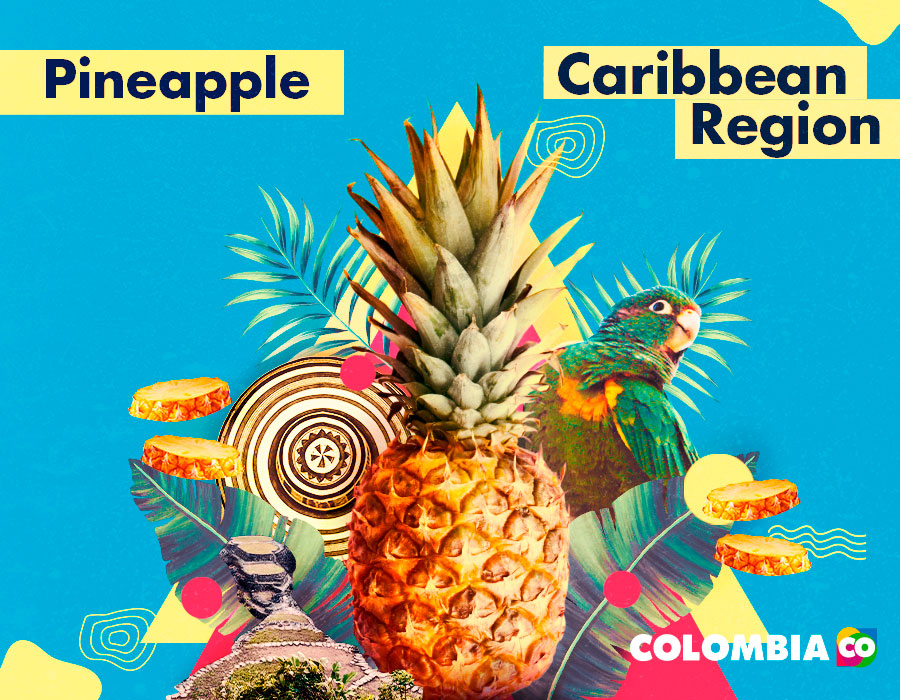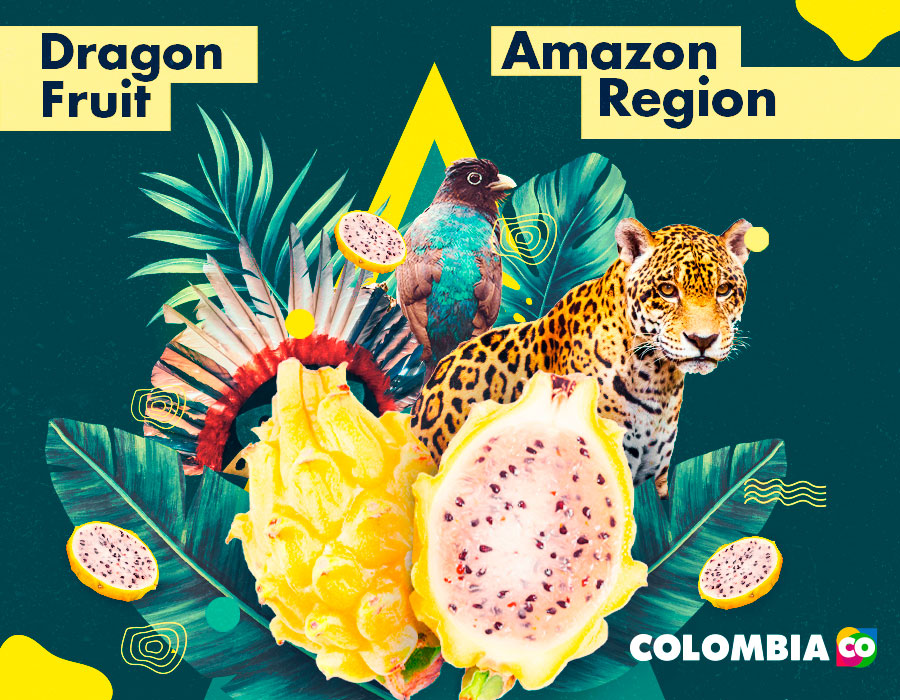COLOMBIA
Discover the tropical fruits of Colombia and the wonderful places where they come from
COLOMBIA

Colombia produces a great variety of tropical fruits due to its excellent geographical location. Located in the equatorial zone of the continent, it is provided with year-round sunlight and optimal conditions for cultivation. Learn more about the most popular fruits of each region.
Avocado, one of the most coveted tropical fruits in the Andean Region

A composition with the most representative elements of the Andean Region.
Considered a superfood due to the large amount of nutrients it contains, such as folic acid and vitamins B6 and E, avocados are also considered low sugar fruits. Of the tropical fruits, it is perhaps the only one with a high content of monounsaturated fatty acids. This is one of its great benefits since consuming this type of fat helps reduce cholesterol and triglycerides, replacing saturated fats. It is one of many fruits that grow in Colombia seasonally.
Usually, it is consumed in salads, ceviches, and even healthy fruit smoothies.
About the Andean Region
The Andean Region runs throughout the center of the country. It is made up of 10 departments, states or subregions: Antioquia, Boyacá, Caldas, Cundinamarca, Huila, Norte de Santander, Quindío, Risaralda, Santander and Tolima. It is the most populated region in Colombia and is named after the Andes, the second highest mountain range system in the world with an extension of 8,900 km that crosses much of the South American continent. Its highlands, valleys, volcanoes and plateaus make it home to various ecosystems that host thousands of species of fauna and flora.
Other Colombian fruits that grow in the region are: cape gooseberry, tree tomato, passion fruit, granadilla, watermelon, melon, guava and an assortment of other tropical fruits.
Activities you can do in the region
- Enjoy a hot air balloon ride with Globos Colombia in the Coffee Cultural Landscape that was declared a World Heritage Site by UNESCO.
- Try mountain tourism in Los Nevados National Natural Park. Encounter the fauna and flora of the moors and different mountain ecosystems on your hike.
- Dare to paraglide through one of the most beautiful landscapes of Colombia at 1554 meters high in the Chicamocha Canyon.
Gulupa, one of the main exotic fruits in the Pacific Region

The gulupa and other representative elements of the Pacific Region.
One of the most unique fruits that grow in Colombia, which is also known as "purple passion fruit." It is a slightly acidic fruit with a delicious flavor and aroma. It boasts fantastic antioxidant properties, helping reduce high blood pressure and improve digestive function. It does not belong to a “fruits in season” calendar, since it grows year-round.
Being one of the most delicious exotic fruits, it is ideal for healthy fruit smoothies, cocktails, desserts, and jams.
The charm of the Pacific Region and tropical fruits
Located in the west of the country, the Pacific Region includes the departments or subregions of Chocó and the coastal area of Valle del Cauca, Cauca and Nariño. It borrows its name from the Pacific Ocean which it borders to the west. This region of Colombia is celebrated for being the home of the Afro-Colombian and Indo-American populations of the country. For this reason, the Colombian Pacific is one of the most culturally expressive regions, reflected in its music, gastronomy, crafts, hairstyles and celebrations.
On the other hand, it is one of the most biodiverse regions in the world. Its great ecology, water supply and wealth of forests make it home to large natural national parks.
The tropical fruits that occur in the region are chontaduro, borojó, loquat and sapodilla, among others.
In addition to enjoying the tropical fruits of this region, you can also try these activities
- From August to November you can enjoy the wonderful spectacle of seeing humpback whales migrate to the Pacific Ocean.
- Find wonderful creatures like the whale shark and other species diving in the Malpelo Fauna and Flora Sanctuary.
- Enjoy the best musical, gastronomic and cultural exhibition of this region every August at the Petronio Álvarez Festival in Cali.
You might also be interested: Unwind and uncover the secrets of a true Caribbean culture
The pineapple is the queen of the tropical fruits in the Caribbean Region

Pineapple is one of the most representative tropical fruits of the Colombian Caribbean.
Pineapple is one of the most popular Colombian fruits for its refreshing and sweet flavor. Due to the amount of bromelain it has, it is excellent for stimulating digestion. Furthermore, it has diuretic and detoxifying properties due to its high content of water and fiber. It is a fruit with little caloric content, and for this reason it is a key element of many dietary regimens. It is rich in vitamin C and essential minerals.
Like other tropical fruits, it is versatile in almost every culinary application, such as sauces, fruit skewers, juices and compotes. It belongs to a special group of Colombian fruits that are produced by region, as it is not only found in the Caribbean region, but also in the Andean and the Pacific as well.
Get to know the Caribbean Region
Located in the north of the country, this region is made up of the subregions of Atlántico, Bolívar, Cesar, Córdoba, La Guajira, San Andrés and Providencia, Magdalena and Sucre. It bears his name because it borders the Caribbean Sea to the north. It comprises a diversity of ecosystems ranging from dry to humid forests. The flora in the region is very exotic and ranges from beautifully colored corals to species such as mangroves. In the same way, the Caribbean Region comprises a wide variety of climates that can range from warm on the beach to temperate in the mountains. For this reason, the cultivation of other tropical fruits such as tamarind, corozo, banana and papaya, among other types of fruits, is possible.
Have fun with these activities in the Caribbean Region
- Practice kitesurfing and windsurfing in Cabo de la Vela in La Guajira and enjoy the beautiful landscapes of the region that offer a mix between beach and desert.
- Enjoy all that Sierra Nevada de Santa Marta has to offer: beaches, ecotourism and bird watching all in one of the most sacred places in the region.
- Be sure to visit the beautiful colonial streets of Mompóx, better known as "the town where time stood still" where you can buy beautiful handicrafts.
Pitahaya or the dragon fruit, one of the exotic fruits of the Amazon Region

A collage of the most representative elements of the Amazon region.
This fruit is also known as "the queen of the night" because its flowers open at night, giving off a pleasant and powerful aroma. Of the fruits that grow in Colombia, the pitahaya is quite popular for its medicinal properties which aid in intestinal transit (even sometimes as a laxative) and digestive. In addition, it has diuretic properties and a high content of fiber, minerals and vitamins.
It can be consumed by scooping out the pulp directly with a spoon or in healthy fruit smoothies.
Although dragon fruit grows almost throughout the year, it belongs to the fruits in season category, dictating that it produces more in some months than in others. For example, in the first half of the year, you can get it only in April and June. In the second half, it is available from July to November.
The great treasures of the Amazon Region
Located in the extreme south of the country, this region comprises around 40% of the Colombian territory, and is the least inhabited in the country. The subregions that are part of the Amazon Region are: Amazonas, Caquetá, Guainía, Guaviare, Meta, Putumayo, Vaupés and Vichada. It is a territory with vast forestry and hydrographic value. As its name suggests, it is home to the longest and largest river in the world, the Amazon River.
Due to the great extent of its jungle, this region is also known as "the lung of the world". Consequently, very exotic mammals such as the pink river dolphin, the manatee, the jaguar and the giant otter are also found here.
Other exotic fruits that grow in the region are the arazá, the copoazú, the lulo and the azaí, among others.
In addition to consuming different types of fruits, you can marvel at these activities
- Fly over the imposing landscape of the Serranía del Chiribiquete National Natural Park, declared a World Heritage Site by UNESCO.
- Immerse yourself in the biodiversity of Leticia’s fauna and flora, and in the different tourist activities you can enjoy there.
- Go on a river expedition to the beautiful Mavecure hills in Guainía and discover the wonderful river star where 4 rivers converge.
You might also be interested: Do you want to know how the is weather in Colombia?
Mango, one of the tropical fruits of the Orinoquía Region

Mango is one of the richest fruits in Colombia.
There are many varieties of mango that can be differentiated by color, shape, pulp and flavor. It is one of the most consumed tropical fruits in the world, not only for its rich flavor but for the large amount of nutrients and vitamins it provides. It is recommended to strengthen the heart as it helps prevent cardiovascular disease.
To the surprise of many, it is one of the low sugar fruits you can find. For this reason, it is a very versatile fruit that can be integrated into different types of cuisine; from ceviches and sauces for meat products, to desserts and even fruit skewers.
Discover the Orinoquía Region and other tropical fruits
This region is located in the eastern part of the country and includes the Arauca, Casanare, Meta and Vichada subregions. In the country it is also known as the "eastern plains" because it is characterized by being a great plain. The region is crossed by the Orinoco River basin, one of the longest rivers on the continent for which the region bears its name.
The region has a climate between warm and dry with savanna vegetation, which presents a varied fauna. Other tropical fruits that grow in the region are lemon, tangerine and soursop.
Activities that will surprise you in this region
- Dare to know Caño Cristales, better known as "the river of seven colors" due to the beautiful hues that its aquatic flowers display when exposed to the sun
- Dare to climb the Sierra Nevada del Cocuy, the largest glacier in Colombia with 18 peaks covered in perpetual snow.
- Discover the wonder of glamping in the middle of a remote nature reserve full of wildlife at the Cocora Camp luxury camp.
Dare to try the tropical fruits of Colombia and let yourself be enveloped not only by its nutritional properties, but by the charm of the regions that they come from.



















